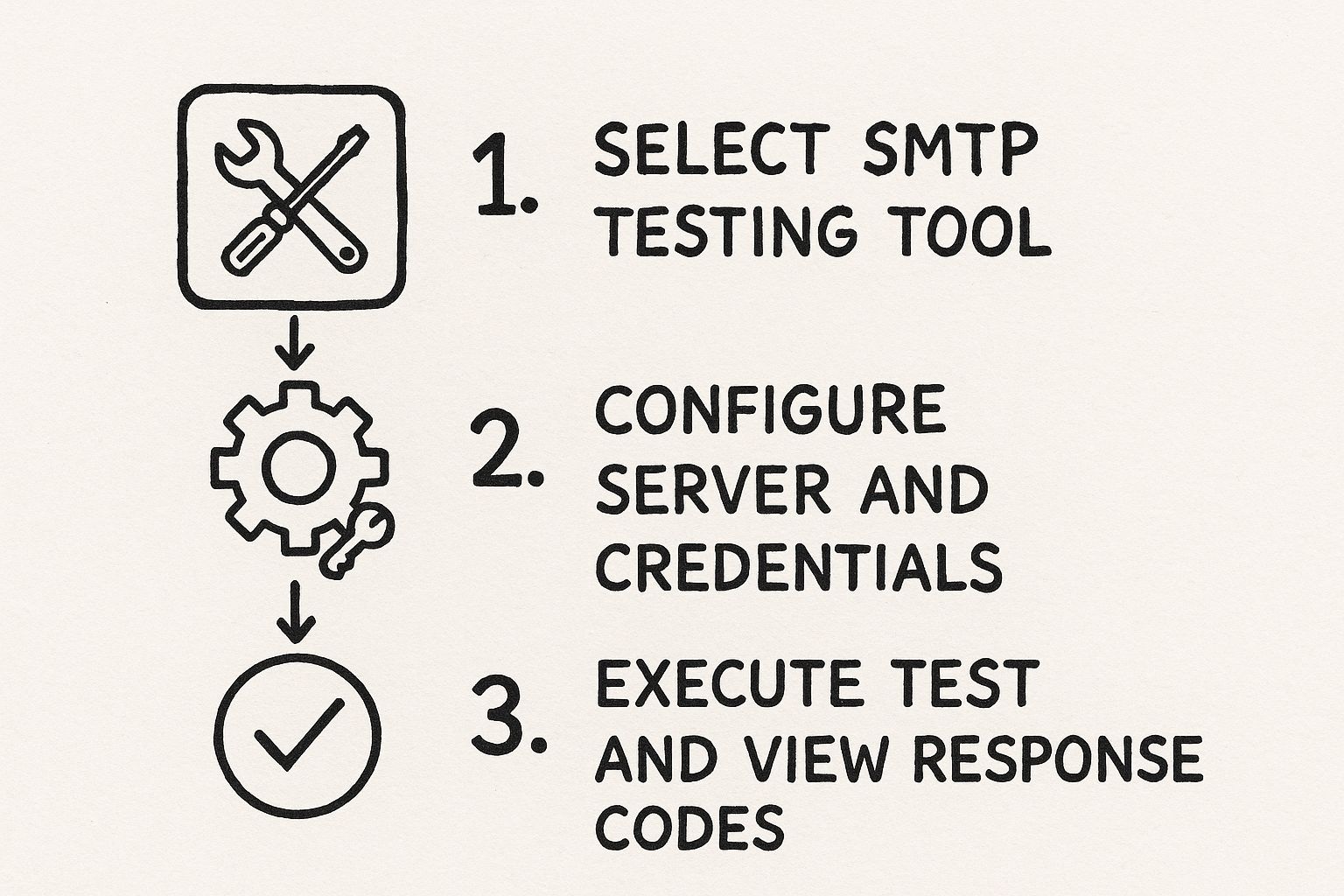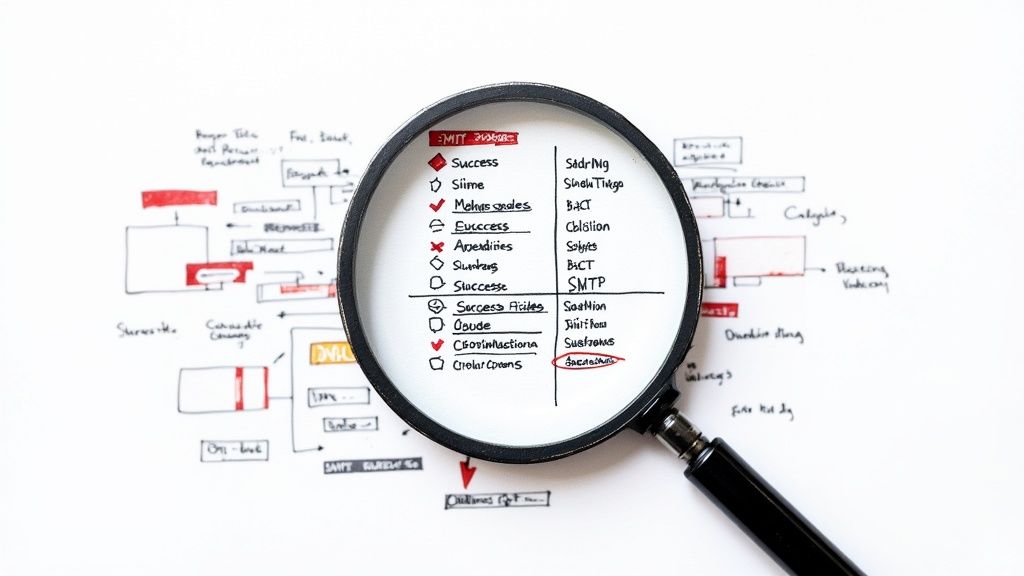Testing an SMTP server means checking if it can properly send and receive emails. This is absolutely critical for reliable communication.
The process makes sure your authentication, port connectivity, and deliverability are all working as they should. It's what stops your most important messages—from sales quotes to password resets—from vanishing into a digital black hole. Think of it as a health check for your email's entire delivery system.
Why SMTP Server Testing Is a Business-Critical Skill

It’s easy to dismiss SMTP server testing as just another technical chore, but that’s a huge mistake. In reality, it’s a core business function that directly impacts your bottom line, customer relationships, and day-to-day operations. A single email delivery failure can set off a chain reaction of negative consequences.
Just imagine a potential customer who never gets your quote. Or a new user who can't receive their account verification link. What about an urgent internal alert that never arrives? These aren't just IT glitches; they are lost opportunities and breaches of trust.
The True Cost of Email Failure
The real-world fallout from a faulty SMTP setup is massive. Your email server is the engine behind countless business processes, and when it starts to sputter, the whole operation can grind to a halt. Proactive testing is your best defense against these costly problems.
- Protecting Revenue: Transactional emails, like order confirmations and shipping updates, are non-negotiable. When they fail, you get frustrated customers and a flood of support tickets, which eats away at your profits.
- Maintaining Customer Trust: When a customer expects an email and it never shows up, they don't blame the protocol—they blame your brand. Consistent, reliable delivery builds the confidence that keeps them coming back.
- Ensuring Operational Stability: So many internal workflows, from security alerts to system reports, depend on email. A misconfigured server can disrupt everything without anyone even noticing until it’s far too late.
Getting a handle on this means looking at the bigger picture and learning how to improve email deliverability across the board.
An unhealthy SMTP server silently undermines your business. It doesn't announce its failures with a loud crash but with a quiet absence—the sound of missed connections and lost revenue.
Beyond Delivery: A Look at Security and Compliance
Proactive testing isn’t just about making sure emails arrive; it's also non-negotiable for security and compliance. An improperly configured server can be an open invitation for spammers to exploit your domain, wrecking your sender reputation and landing you on blacklists.
On top of that, with data privacy laws like GDPR getting stricter, ensuring that emails are sent securely and reliably is often a legal requirement. Testing confirms that your encryption protocols are actually working, which is essential for protecting sensitive information in transit. Our own guide on how to check your SMTP server dives deeper into these validation steps.
The sheer growth of email infrastructure makes this even more pressing. The global cloud-based mail server software market is expected to reach USD 12.56 billion in 2024, a surge driven by remote work and the demand for scalable, dependable communication. This expansion makes SMTP testing more critical than ever.
Ultimately, mastering SMTP testing isn't just about being technically proficient. It’s about strategic business protection. It's how you ensure your most vital communication channel stays open, secure, and trustworthy.
Your Pre-Flight Checklist Before You Test Anything
 Jumping straight into a technical test without a little prep is a recipe for frustration. It's like trying to fly a plane without doing your pre-flight check—you might get off the ground, but you’re setting yourself up for headaches that were totally avoidable.
Jumping straight into a technical test without a little prep is a recipe for frustration. It's like trying to fly a plane without doing your pre-flight check—you might get off the ground, but you’re setting yourself up for headaches that were totally avoidable.
A bit of groundwork makes the whole process of testing your SMTP server smoother and gets you the right answers, faster.
Think of this as your setup guide. Before you run a single command, you need to grab three key pieces of information. Trust me, having these details ready will sidestep the most common connection problems right out of the gate.
Gather Your Server Credentials
First up, you need your SMTP server's address, which is often called the hostname. This is the destination your email client or application connects to. It usually looks something like smtp.yourprovider.com or mail.yourdomain.com.
Next, you need the right authentication credentials—your username and password. In most cases, the username is your full email address, but some services might use an API key or a specific login format. It's worth double-checking this, as a simple typo is one of the most frequent reasons for authentication failures.
You can usually find these details in a few spots:
- Your email provider's documentation: Services like Google Workspace or Microsoft 365 have dedicated help pages with all their SMTP settings.
- Your web hosting control panel: If you're using cPanel or Plesk, look for an "Email Accounts" section. The configuration details are usually displayed there.
- Your application's configuration file: For a custom app, these settings are typically stored in a file like
.envorweb.config.
Choose the Right Port
The final piece of your pre-flight check is the SMTP port. Think of a port as a specific door on the server. Using the right one is non-negotiable for a secure and successful connection.
While you might see a few different port numbers floating around, you'll mainly deal with three.
Port 587 is the modern standard for sending email securely. It uses opportunistic TLS via the STARTTLS command, which has become the go-to method for the industry. This ensures your connection gets encrypted without causing issues for older systems.
Let's break down the common options quickly:
Basically, Port 25 is an old highway notorious for spam, which is why almost every internet service provider blocks it for end-users. Port 465 was an early stab at security but has since been replaced.
Port 587 is the one you should almost always be using. It’s the default for secure email submission and is supported by virtually all modern providers. It starts a connection and then upgrades it to a secure TLS session, giving you the best of both worlds: compatibility and security.
With your hostname, credentials, and the correct port number (which is probably 587) in hand, you're ready to go. This simple checklist dramatically improves your odds of a successful first test and saves you from a lot of unnecessary troubleshooting later.
A Hands-On Guide to Manual SMTP Testing
While online tools are fast and convenient, sometimes you just need to roll up your sleeves and talk directly to your SMTP server. Going manual with command-line tools like Telnet or Netcat is the most direct way to get to the bottom of connection and authentication problems. It’s like having a one-on-one conversation with the server, letting you see exactly where things are breaking down.
This hands-on method pulls back the curtain on the whole process. You'll send commands one at a time and see the server's raw, immediate response. This is gold for troubleshooting because you can pinpoint the exact moment something fails—whether it’s the initial handshake, the login attempt, or the data transfer.
First things first, you’ll need to open your command-line interface. That’s Terminal on macOS or Command Prompt/PowerShell on Windows. The basic idea is to connect to your server's address and port, then walk through the SMTP protocol commands step-by-step.
This visual guide breaks down the typical workflow for any SMTP test, including the manual approach we're about to dive into.

As you can see, the process boils down to three core phases: picking your method, plugging in the right details, and then running the test to see what the server tells you.
Kicking Off the Conversation with HELO and EHLO
Once you’re connected to the server, your first job is to introduce yourself. In the world of SMTP, this is done with either the HELO or EHLO command. EHLO (Extended Hello) is the modern standard and what you should almost always use. It tells the server you can handle extended SMTP commands.
You'll type EHLO followed by your domain or computer name, like so: EHLO mydomain.com.
If all is well, the server will reply with a series of lines, each beginning with the code 250. This is good news. The first 250 is a simple greeting, but the lines that follow are a menu of everything the server can do, like STARTTLS for encryption and AUTH for different login methods.
Key Takeaway: A
250response code is your green light. It means the server understood and accepted your last command. Getting a list of capabilities afterEHLOconfirms you're connected to a modern, properly configured ESMTP server.
If a server balks at EHLO, you can try the older HELO command. But honestly, any server that only responds to HELO is probably ancient.
Handling Authentication Securely
After the handshake, it’s time to log in. Most SMTP servers today won't let you send an email without authenticating first—it’s a crucial step to stop spammers from hijacking your server.
Look through the EHLO response for a line that mentions AUTH. You'll likely see AUTH LOGIN, a common and straightforward method. To start the process, just type that command: AUTH LOGIN.
The server will hit you back with 334 VXNlcm5hbWU6. Don't panic! That's just "Username:" encoded in Base64. Your job now is to provide your username (usually your full email address), also encoded in Base64. You can find plenty of online tools to do the encoding for you.
Once you send your encoded username, the server will prompt for the password with 334 UGFzc3dvcmQ6 (Base64 for "Password:"). Send your Base64-encoded password next.
If you got the credentials right, you’ll see the welcome message: 235 2.7.0 Authentication successful. You're in! Now you have permission to send an email.
Composing and Sending Your Test Email
Now for the fun part: building the actual email. This happens in a three-step sequence using MAIL FROM, RCPT TO, and DATA.
Set the Sender: First, tell the server who the email is from. The command is
MAIL FROM:<sender@example.com>. The server should reply with a250 2.1.0 OK.Name the Recipient: Next, define who you're sending it to with
RCPT TO:<recipient@anotherexample.com>. A successful response here looks like250 2.1.5 OK.Enter the Email Body: Finally, signal you're ready to provide the email's content by typing
DATA. The server will respond with something like354 End data with <CR><LF>.<CR><LF>. This is its way of saying, "Okay, start typing your message, and end it with a single period on its own line."
Now you can type out your email headers (e.g., Subject: My Test Email) and the message body. When you're done, hit Enter, type a single period (.), and hit Enter again. That lone period is the universal signal that you're finished.
If it all worked, the server will accept the message and respond with something like 250 2.0.0 OK: Queued as 12345. This confirms your email is in the queue, ready to be sent. To wrap up, just type QUIT, and the server will close the connection with a 221 Bye message.
This whole field of software testing, which includes the specialized work of testing SMTP servers, is a massive and growing part of the tech industry. In 2023, the software testing market was valued at an impressive USD 51.8 billion and is expected to keep climbing. The rise of AI-driven tools and CI/CD pipelines is constantly changing how SMTP testing gets done, making it more precise and efficient. You can dive deeper into these trends by checking out the latest analysis on the software testing market.
Using Online Tools for Fast and Easy SMTP Testing
While the command line gives you a direct, unfiltered look at your SMTP server, it’s not always the quickest or most convenient option. Let's be honest, sometimes you just need a fast answer without firing up a terminal.
This is where online SMTP testing tools shine. They take a multi-step diagnostic process and boil it down to a simple web form. You plug in your server details—hostname, port, and credentials—click a button, and get a full report in seconds. It’s an incredibly simple way to get the job done, no matter your technical background.
These tools are built for one purpose: testing an SMTP server. They deliver clear, easy-to-understand feedback without the manual back-and-forth of a command-line connection.
The Major Advantages of Using a Web-Based Tester
One of the biggest wins here is pure speed. A test that might take you several minutes to type out manually is over in less than 30 seconds with a web tool. When you're troubleshooting an urgent email problem, that efficiency is a lifesaver.
But the real game-changer is the ability to test your server from a neutral, third-party location. This is absolutely critical for tracking down certain types of issues.
- Sidestep Local Network Problems: Think your office firewall or a funky network setting is blocking your connection? Testing from an external server confirms or denies that suspicion in an instant.
- Confirm Public Accessibility: An online tool is the perfect way to make sure your SMTP server is actually open to the outside world—a common hurdle for new server setups.
- Get an Unbiased Result: The test comes from a clean, independent source, so you can rule out any weirdness from your own computer or internet provider.
By testing from an external vantage point, you eliminate that nagging "is it just me?" question that complicates so many troubleshooting sessions. The tool acts as an impartial judge, giving you a definitive answer on your server's public reachability.
How to Choose the Right SMTP Testing Tool
A quick search will show you that not all online SMTP testers are the same. Many are free and do the basic job, but they can differ quite a bit in their features, security, and the depth of information they give you.
For a simple "is it on?" check, any basic tool will probably do. But if you're wrestling with ongoing deliverability problems or need to check security protocols like TLS encryption, you'll want something more powerful.
So, how do you pick? Here are some of the most popular online tools and what they're best for. This should help you find the right fit for your situation.
Comparison of Online SMTP Testing Tools
This table compares key features of popular online SMTP test services to help you choose the best one for your needs.
Many of these services, like our own at PlusVibe, are part of a larger email delivery platform. These integrated solutions are great because you can test your settings and then start sending your campaigns, all from the same dashboard.
Ultimately, using an online tool is about saving time and getting clearer insights. For the vast majority of day-to-day checks, it’s the most efficient way to confirm your SMTP server is online, properly authenticated, and ready to go.
Solving Common SMTP Connection Problems

When an SMTP test fails, it’s easy to feel that pit-in-your-stomach dread. But don't panic. Most connection issues boil down to a handful of common, fixable problems. Think of this section as your troubleshooting field manual, here to turn confusing error messages into clear, actionable solutions.
Instead of just giving you a dry list of error codes, we’ll walk through the real-world headaches you're most likely to hit. From frustrating authentication hiccups to baffling timeouts, let's get you back on track and your emails flowing.
Diagnosing Authentication Failures
One of the most frequent roadblocks is an authentication error. You’ll usually see a response like 535 Authentication failed or something similar. The message is blunt: the server doesn't recognize the credentials you’re using.
It sounds almost too simple, but the first thing to do is always double-check your username and password for typos. A single wrong character can bring everything to a halt. Also, keep in mind that some services need your full email address as the username, while others might use a specific login name or even an API key.
If you’re positive the credentials are correct, the problem might be the authentication method itself.
- Check the
AUTHtype: When you connect with theEHLOcommand, the server tells you which authentication methods it supports, likeAUTH LOGINorAUTH PLAIN. Make sure your tool is using one of these. - Base64 Encoding: If you're testing manually with
AUTH LOGIN, don't forget that your username and password must be Base64 encoded before you send them. A quick search for an online converter will get this done in seconds.
Getting past these authentication snags is usually just a matter of careful, methodical checking. Once you solve it, you've cleared a major hurdle. To dive deeper into ensuring your emails not only send but also land in the inbox, it's worth learning how to improve email deliverability.
Tackling Connection Timeouts and Port Issues
Another all-too-common problem is the connection timeout. This is what happens when your client just can't seem to establish a link with the SMTP server. More often than not, the culprit is a firewall or a blocked port.
Lots of internet service providers (ISPs) and cloud hosts block Port 25 by default to clamp down on spam. If you're trying to connect on this port from your home network or a standard virtual server, it’s almost guaranteed to fail.
The go-to solution is to switch to Port 587. This is the standard, secure port for email submission and is rarely blocked. It uses STARTTLS to encrypt your connection, making it the modern best practice. If 587 also fails, some providers offer an alternate like Port 2525.
If swapping ports doesn't do the trick, a firewall—either on your local machine, your office network, or the server itself—is likely the next suspect. A quick way to diagnose this is to temporarily disable your local firewall and see if the connection goes through.
Understanding the "Relaying Denied" Error
The dreaded 554 5.7.1 Relay access denied error is a classic sign of a server misconfiguration. This message means the server heard your request but is flat-out refusing to send the email on your behalf to an outside domain.
This isn't just the server being difficult; it's a critical security measure. It's designed to prevent spammers from hijacking the server and using it as an "open relay" to blast out unsolicited emails, a practice that would quickly get your server's IP address blacklisted.
The fix nearly always comes back to authentication. Most SMTP servers will only relay mail for users who have logged in successfully.
- Authenticate First: Make sure you've successfully logged in with a command like
AUTH LOGINbefore you try to send mail withMAIL FROM. - Check Server Rules: Some servers are configured to only allow sending from specific email addresses or domains. Double-check that the "From" address you're using is on the approved list.
Frequently Asked Questions About SMTP Testing
Even with a step-by-step guide, you're bound to run into some specific questions when you're in the weeds of testing an SMTP server. This section is all about giving you quick, practical answers to those common sticking points.
Let's clear up any lingering confusion so you can get your tests done right.
What Is the Difference Between an SMTP Server and an SMTP Relay?
This is a fantastic question because people throw these terms around interchangeably, but they really do have distinct roles. An SMTP server is the whole enchilada—the full application that sends, receives, and queues up email. It's the central command for all your mail activity.
An SMTP relay, on the other hand, is more of a specific action. It’s simply the process of one server handing off an email to another. When your Gmail account sends a message to a Yahoo account, a relay service is what bridges the gap between those two domains. In fact, many third-party email services you might use are technically "SMTP relay services," as their main job is to take your email and relay it to its final destination.
Why Do Some SMTP Tests Fail Even with the Right Credentials?
Ah, the classic head-scratcher. You've triple-checked your username and password, you know they're correct, but you keep getting an authentication error. The culprit usually isn't the credentials themselves, but the authentication method or encryption requirements.
For example, your server might demand a secure connection using STARTTLS on port 587 before it even looks at your login attempt. If your testing tool tries to connect without initiating that secure TLS handshake first, the server will slam the door shut, regardless of how perfect your password is.
The key takeaway here is to look beyond just the username and password. A failed login is often a symptom of something else: the wrong port, a missed encryption step, or your tool trying an authentication method like
AUTH PLAINwhen the server is expectingAUTH LOGIN.
Can I Test an SMTP Server Without Sending an Actual Email?
Absolutely. In fact, this is exactly what most initial diagnostic tests do. When you connect manually with a tool like Telnet or use an online SMTP checker, you can run through the entire connection and authentication process without ever hitting "send."
You can perform these steps to confirm connectivity and access:
- Establish a connection to the server on the correct port.
- Send the
EHLOcommand to see what the server can do. - Use the
AUTH LOGINcommand and provide your credentials.
If you get back a 235 Authentication successful message, you've nailed it. You've confirmed the server is reachable and your login works—the most critical parts of the process. From there, you can just send the QUIT command to close the connection, no email sent.
Does a Successful SMTP Test Guarantee Inbox Placement?
No, and this is a crucial distinction to make. A successful SMTP test confirms one thing and one thing only: that your server is technically set up to accept and send an email. It means your configuration, ports, and authentication are all working as they should.
However, it tells you nothing about email deliverability—whether that email will actually land in the recipient's inbox. Getting to the inbox is a much more complex game influenced by dozens of factors, like your sender reputation, domain authentication (think SPF and DKIM), the content of your email, and the quality of your recipient lists. Proper email verification is a non-negotiable first step to stop your messages from bouncing.
Think of it this way: testing your SMTP server is like making sure your car's engine starts. It's an essential first step, but it doesn't guarantee you won't hit a traffic jam on the way to your destination.
Ready to stop troubleshooting and start sending? With PlusVibe, you get a powerful email platform with built-in deliverability tools and a simple setup process. Stop wrestling with server settings and focus on growing your business. Try PlusVibe today and experience seamless email outreach.














































.jpeg)


.png)























































